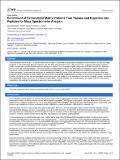| dc.contributor.author | Clauser, Karl R. | |
| dc.contributor.author | Naba, Alexandra | |
| dc.contributor.author | Hynes, Richard O. | |
| dc.date.accessioned | 2017-01-20T15:11:20Z | |
| dc.date.available | 2017-01-20T15:11:20Z | |
| dc.date.issued | 2015-07 | |
| dc.identifier.issn | 1940-087X | |
| dc.identifier.uri | http://hdl.handle.net/1721.1/106549 | |
| dc.description.abstract | The extracellular matrix (ECM) is a complex meshwork of cross-linked proteins that provides biophysical and biochemical cues that are major regulators of cell proliferation, survival, migration, etc. The ECM plays important roles in development and in diverse pathologies including cardio-vascular and musculo-skeletal diseases, fibrosis, and cancer. Thus, characterizing the composition of ECMs of normal and diseased tissues could lead to the identification of novel prognostic and diagnostic biomarkers and potential novel therapeutic targets. However, the very nature of ECM proteins (large in size, cross-linked and covalently bound, heavily glycosylated) has rendered biochemical analyses of ECMs challenging. To overcome this challenge, we developed a method to enrich ECMs from fresh or frozen tissues and tumors that takes advantage of the insolubility of ECM proteins. We describe here in detail the decellularization procedure that consists of sequential incubations in buffers of different pH and salt and detergent concentrations and that results in 1) the extraction of intracellular (cytosolic, nuclear, membrane and cytoskeletal) proteins and 2) the enrichment of ECM proteins. We then describe how to deglycosylate and digest ECM-enriched protein preparations into peptides for subsequent analysis by mass spectrometry. | en_US |
| dc.description.sponsorship | United States. Department of Defense (DOD Innovator Award W81XWH-14-1-0240) | en_US |
| dc.description.sponsorship | National Cancer Institute (U.S.) (Grant U54 CA126515/CA163109) | en_US |
| dc.description.sponsorship | Broad Institute of MIT and Harvard | en_US |
| dc.description.sponsorship | Howard Hughes Medical Institute | en_US |
| dc.description.sponsorship | National Cancer Institute (U.S.) (David H. Koch Institute for Integrative Cancer Research at MIT. Grant P30-CA14051) | en_US |
| dc.language.iso | en_US | |
| dc.publisher | MyJoVE Corporation | en_US |
| dc.relation.isversionof | http://dx.doi.org/10.3791/53057 | en_US |
| dc.rights | Creative Commons Attribution-NonCommercial-NoDerivs License | en_US |
| dc.rights.uri | http://creativecommons.org/licenses/by-nc-nd/3.0/ | en_US |
| dc.source | Journal of Visualized Experiments (JoVE) | en_US |
| dc.title | Enrichment of Extracellular Matrix Proteins from Tissues and Digestion into Peptides for Mass Spectrometry Analysis | en_US |
| dc.type | Article | en_US |
| dc.identifier.citation | Naba, Alexandra, Karl R. Clauser, and Richard O. Hynes. “Enrichment of Extracellular Matrix Proteins from Tissues and Digestion into Peptides for Mass Spectrometry Analysis.” Journal of Visualized Experiments 101 (2015): n. pag. | en_US |
| dc.contributor.department | Massachusetts Institute of Technology. Department of Biology | en_US |
| dc.contributor.department | Koch Institute for Integrative Cancer Research at MIT | en_US |
| dc.contributor.mitauthor | Naba, Alexandra | |
| dc.contributor.mitauthor | Hynes, Richard O. | |
| dc.relation.journal | Journal of Visualized Experiments | en_US |
| dc.eprint.version | Final published version | en_US |
| dc.type.uri | http://purl.org/eprint/type/JournalArticle | en_US |
| eprint.status | http://purl.org/eprint/status/PeerReviewed | en_US |
| dspace.orderedauthors | Naba, Alexandra; Clauser, Karl R.; Hynes, Richard O. | en_US |
| dspace.embargo.terms | N | en_US |
| dc.identifier.orcid | https://orcid.org/0000-0001-7603-8396 | |
| dspace.mitauthor.error | true | |
| mit.license | PUBLISHER_CC | en_US |
